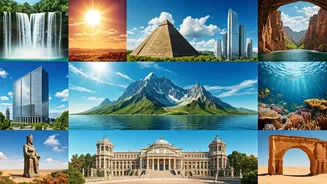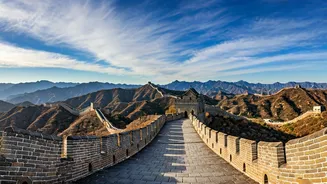Great Wall of China
Stretching thousands of miles across northern China, the Great Wall stands as a testament to human ingenuity and perseverance. Built over centuries, it served
as a defensive fortification, guarding the Chinese empire from invaders. Today, it offers a glimpse into China's rich history, with its towers, watchtowers, and the winding wall itself providing stunning views and a sense of awe. Visitors can walk along sections of the wall, imagining the soldiers and workers who constructed this incredible structure. The sheer scale of the Great Wall, visible even from space, underscores its enduring legacy as one of the world's most impressive architectural feats.
Petra, Jordan's Rose City
Carved into sandstone cliffs, Petra, often called the 'Rose City' for the color of its stone, is a marvel of ancient Nabataean civilization. This lost city, rediscovered in the 19th century, features elaborate facades, tombs, and temples, showcasing remarkable architectural skills. The Treasury, a highlight of Petra, is a stunning example of intricate carvings. Exploring Petra involves traversing narrow canyons, leading to hidden structures. The site's dramatic landscape and detailed architecture provides a trip back in time, allowing visitors to witness the skill of the Nabataean people and the beauty of this once-thriving trading hub.
The Colosseum, Rome
The Colosseum, an iconic symbol of ancient Rome, is a vast amphitheater that once hosted gladiatorial contests, public executions, and mock sea battles. Built during the Flavian dynasty, it could accommodate tens of thousands of spectators. Today, the Colosseum stands as a reminder of Rome's power and grandeur. Visitors can walk through its remains, exploring the seating levels, passageways, and the underground areas. This historic site is a window into the entertainment and social life of ancient Romans, a location with a rich history and stories of ancient gladiators and their battles.
Machu Picchu, Peru
High in the Andes Mountains, Machu Picchu is a lost city of the Inca civilization. This complex of temples, palaces, and plazas, perfectly integrates with its natural surroundings. Built in the 15th century, Machu Picchu was abandoned, preserving its mystery and beauty. The site's precise stonework and stunning mountain views captivate visitors. Reaching Machu Picchu involves a scenic train journey or a trek along the Inca Trail. The mysterious origins, combined with the breathtaking landscape, have made it one of the most visited and enigmatic sites in the world.
Chichen Itza, Mexico
Chichen Itza, a major city in the Yucatán Peninsula, showcases the influence of the Mayan and Toltec civilizations. Its centerpiece, the El Castillo pyramid, is a testament to the advanced astronomical knowledge of the Mayans. The site includes various temples, ball courts, and observatories. During the spring and autumn equinoxes, sunlight creates a shadow on the pyramid, appearing to be a serpent slithering down the structure. Chichen Itza shows a rich cultural heritage and historical importance, offering a glimpse into the sophisticated societies that once thrived in the region.
Taj Mahal, India
The Taj Mahal, a mausoleum in Agra, India, is a symbol of eternal love. Commissioned by Mughal emperor Shah Jahan for his wife Mumtaz Mahal, the white marble structure is renowned for its symmetry, intricate details, and the beauty of its gardens. The Taj Mahal is a masterpiece of Mughal architecture. It incorporates Persian, Islamic, and Indian design elements. Visitors come to admire its beauty, a testament to the love and devotion of Shah Jahan and a highlight of India's cultural and architectural heritage. The building's precise construction and the use of precious materials make it an unforgettable experience.
Christ the Redeemer, Brazil
Perched atop Corcovado Mountain in Rio de Janeiro, Christ the Redeemer is a colossal statue that symbolizes peace and welcomes visitors to the city. The statue, with outstretched arms, offers stunning views of Rio de Janeiro. Constructed of concrete and soapstone, it was completed in 1931 and has become an iconic symbol of Brazil. Reaching the statue involves a scenic train ride or van trip through Tijuca National Park. It is a must-see for travelers and locals alike and serves as a significant landmark.
Iguazu Falls, Argentina/Brazil
Iguazu Falls, located on the border of Argentina and Brazil, is a collection of hundreds of waterfalls that form a breathtaking natural spectacle. The falls are surrounded by lush rainforest, and the sheer power of the water creates an overwhelming sensory experience. The most famous is the 'Devil's Throat,' a horseshoe-shaped cataract that is the largest. Visitors can explore the falls from various viewpoints, taking boat trips that bring them close to the cascades. The vastness of the falls makes it a remarkable natural wonder.
The Pyramids of Giza, Egypt
The Pyramids of Giza, located near Cairo, are ancient structures that served as tombs for the pharaohs. The Great Pyramid of Giza, built for Pharaoh Khufu, is the largest, demonstrating incredible engineering and mathematical skill. Alongside the pyramids are the Sphinx, a monumental statue with the body of a lion and the head of a human. These ancient wonders continue to captivate visitors, inspiring wonder at the scale and precision of their construction. They represent the civilization that thrived in ancient Egypt.











